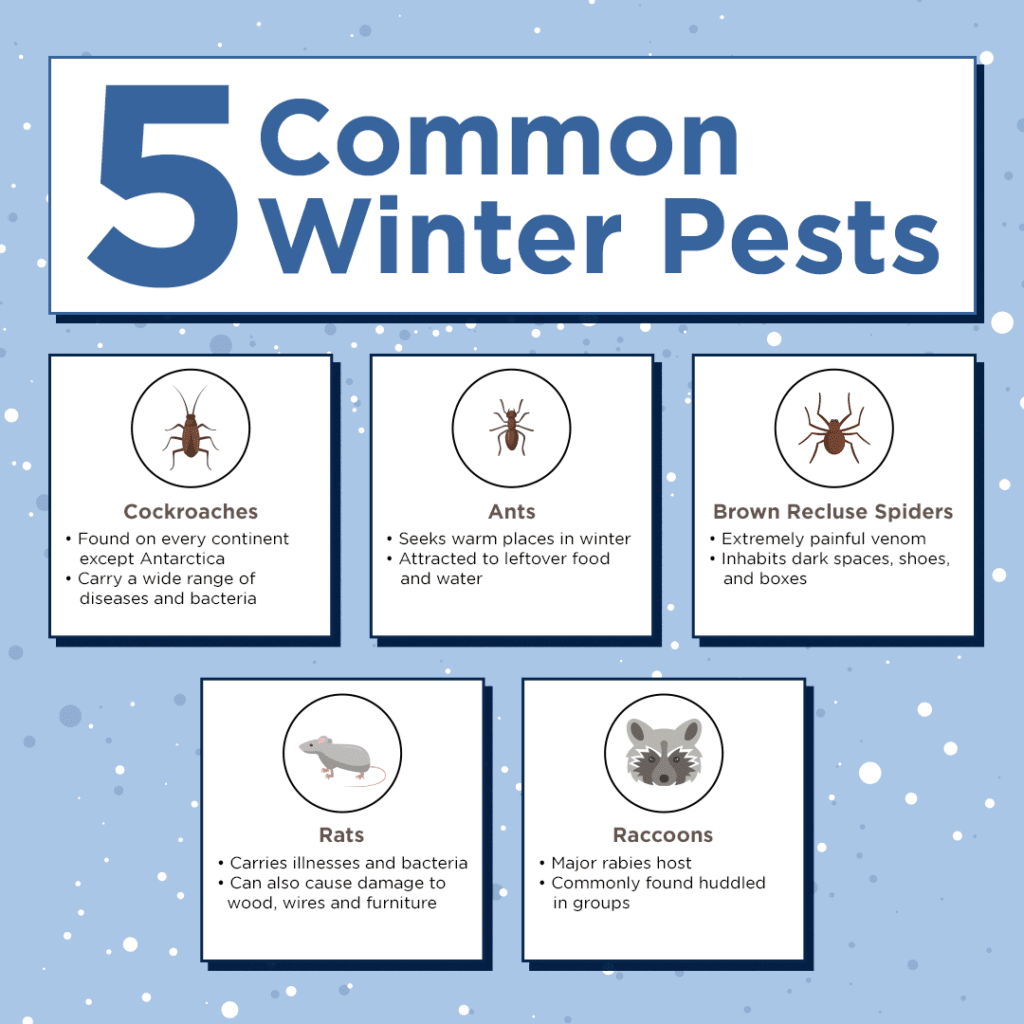When the holidays roll around, you can expect the seasonal pesky things to come too. Christmas carolers, annoying relatives, and of course… pests.
While we can’t do anything about your dreaded in-laws, we know a thing or two about winter pests. Here are five common critters that come out during the cold season, and how you can root them out from your home.
Cockroaches
The bane of households around the world, cockroaches can be found on every continent except Antarctica. They carry a wide host of diseases, including nasty bacteria like salmonella, staphylococcus, and streptococcus, and intestinal parasites that can cause diarrhea, dysentery, all the way to cholera and typhoid fever.
According to the National Pest Management Association, roaches are also one of the most common sources of indoor allergens, with up to 63% of American homes containing such allergens. Children are much more susceptible to cockroach allergies than adults.
Common roach species that can be found in the US include:
- American cockroach (Periplaneta americana)
- German cockroach (Blattella germanica)
- Oriental cockroach (Blatta orientalis)
- Brown-banded cockroach (Supella longipalpa)
Solution:
Roaches are a hardy bunch, and total eradication is extremely difficult. The best thing you can do to limit their spread is to reduce their access to food, water and shelter.
Food and water
- Keep counters, tabletops, and floors clear of any food debris
- Don’t let garbage sit overnight: dispose of it everyday
- Vacuum frequently to get rid of tiny food particles and scraps that may not be evident to the naked eye
- Wipe up spills immediately, don’t let them soak on the floorboards and carpet.
- Don’t leave pet food out if possible, and clean their bowls
- Fix leaky taps and pipes
Shelter
- Seal entry points to your home, such as cracks and gaps. Besides, these also serve as heat loss sources in winter.
- Use roach traps. Pay attention to dark and damp areas, corners, closets and undersinks.
Ants
Another prolific pest the world over, ants are masters of overwintering. When the cold comes, their body temperatures drop to conserve energy. This causes them to seek warm places, such as deep soil, tree interiors, and of course, the cosy inviting warmth of your home.
Like roaches, you can limit their intrusion by denying access to food and shelter.
Solution:
- Get rid of things that attract ants, including:
Leftover food on countertops and floors
Pet food in bowls
Encrusted food in the sink and kitchen tiles
Open food containers
- Wipe down ant trails with bleach or ammonia-based cleaners to eliminate the scent.
- Keep your house clean by vacuuming regularly.
Brown Recluse Spiders
These nasty spiders have a necrotic venom that causes severe pain and gangrene, leaving deep, sometimes permanent scars. Most can be found in the Southeast, particularly Arkansas, Colorado, Kansas, Missouri, Nebraska, Oklahoma, and Texas, but they can reach as far as California.
Brown recluse spiders inhabit dark and undisturbed areas of the house, such as attics, crawl spaces, basements, and rarely opened closets. They can also be found nesting inside shoes, cardboard boxes, and along window moldings.
Solution:
- Trim overhanging branches from the roof, as well as shrubs and foliage too close to the house walls.
- Store shoes in sealed boxes or plastic containers. Other items that may need sealed storage include gloves and mitts.
- Use glue traps in suspect areas.
- Use brown recluse insecticide upon spotting a spider. For passive defense, you can spread diatomaceous earth powder in vulnerable spots.
Rats
As warm-blooded creatures, rats naturally seek the warmth afforded by your house in winter. Common nesting areas include attics, basements, closets, garages, toolsheds, and even piles of debris.
Norway rats are particularly dangerous, since they will gnaw almost anything, even plastic or lead pipes, in addition to furniture and wiring. They can also survive for over a month without water.
Solution:
Home interior
- Deny access to your home by plugging gaps, cracks and holes in exterior walls.
- Eliminate nesting places using rat traps and rodenticides.
- Use natural deterrents like cayenne pepper, black pepper, cloves or peppermint oil.
- Crush pepper also works to ward off rat entryways, as long as they are far away from your HVAC, AC, or humidifier.
House exterior:
- Place dry ice in burrows to asphyxiate rats humanely.
- Keep your lawn trimmed and free of clutter to deny hiding areas.
- Use snap traps, baits and poisons to deny rats from gaining access to the wall perimeter.
Raccoons
Another warm-blooded vermin, racoons are a major host of rabies in the US. In winter, they seek refuge in houses as a denning site. Worse, once they find such a warm refuge, they are apt to stay there for the whole season, leading to a group, or “gaze”, of racoons in your home.
Solution:
- Patch up holes, especially in the attic. Racoons can squeeze through holes the size of a softball.
- Ensure that garbage lids are tightly sealed to prevent unwanted attraction.
- Avoid leaving pet food and water outside at night.
- Apply an equal mix of chili powder and ground garlic around your garden perimeter.
- Use motion-activated lights to deter their nocturnal forays.

